Don Christobal Colon, known in English as Christopher Columbus, has become one of the most controversial of individuals in World History. In August 1492, Columbus and his crews aboard the Pinta, Niña, and Santa Maria departed from Spain for the Indies.1 However, few know what Columbus observed firsthand when he arrived at the first islands he came across. The only thing was, he didn’t know exactly where he was going, and also didn’t know where he ultimately ended up. In an attempt to report his findings to Queen Isabella, Columbus decided to keep a diary from the day of his departure to the time of his return to Spain.2
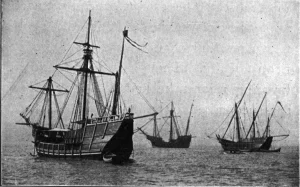
Late in the day on October 11, 1492, the three ships finally arrived to shore, with some hesitation on where to dock because of the unknown area. The Pinta was believed by Columbus to be the “better sailor” of the three ships. The Pinta was the first to find land. The Admiral on the Santa Maria was paying attention closely to where the Pinta was headed. Columbus wrote about this in his diary:
“A sailor named Rodrigo de Triana saw this land first, although the Admiral, at the tenth hour of the night, while he was on the sterncastle, saw a light, although it was something so faint that he did not wish to affirm it was land. But he called Pero Gutierrez, the steward of the king’s dais, and told him that there seemed to be a light, and for him to look: and thus he did and saw it.”3
Well past early morning on Friday, October 12, 1492, Columbus and his crew began to explore the land they had just come upon. The curiosity of this land among him and his fellow sailors began to grow, as it was clear that the land was different from Spain. Of this first contact, Columbus wrote in his diary:
“When they reached an islet of the Lucayas, which was called Guanahani in the language of the Indians. Soon they saw naked people; and the Admiral went ashore in the armed launch, and Martin Alonso Pinzon and his brother Vicente Anes, who was the captain of the Niña. The Admiral brought out the royal banner and the captain’s two flags with the green cross, which the Admiral carried on all ships as a standard, with an F and a Y and over each letter a crown, one on one side and the [Depiction of a Cross] and the other on the other.”4
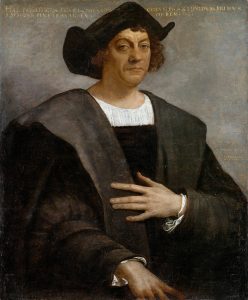
Columbus and his crew began to encounter people living on the land. Columbus constantly referred to these people as “Indians” in his diary. In the original Spanish version, he says “yndios,” which is a direct translation to ‘Indians’ in English.5 The people he encountered often intrigued Columbus, because of their traditions and actions. One thing he assumed while trying to converse with them is that they didn’t have any organized religion. Columbus was an avid Christian, and wrote many excerpts in his diary beginning with prayers and dedications to Christ. His goal wasn’t to convert them, but if he were to convert them because he didn’t know what they believed, he wrote that force wasn’t the option: “Because I recognized that they were people who would be better freed [from error] and converted to our Holy Faith by love than by force…”6 These people were also very familiar with trade, and Columbus engaged with them in trade a couple of times. He would give them things like glass beads, which the Indians put on their chests. They often swam to bring Columbus and his crew cotton, parrots, and more. Columbus summed up his trade experience by writing, “They took everything and gave of what they had very willingly.”7 Columbus planned on leaving with six of the Indians, to give them to the Queen, so he could help them “learn to speak,” as he wrote. Columbus did not encounter any other animals on this island, besides the parrots that were traded.
Columbus did not write an entry on October 12, 1492 for unknown reasons. However, his entry on October 13, 1492 is one of his longest in the entire diary. Early in the morning on the thirteenth, Columbus saw a lot of younger people near the ship, which he described as “handsome,” and that their eye colors resembled some of the Canary Islanders he had encountered:
“All alike have very straight legs and no belly but are very well formed. They came to the ship with dugouts that are made from the trunk of one tree, like a long boat, and all of one piece, and worked marvelously in the fashion of the land, and so big that in some of them 40 and 45 men came. And others smaller, down to some in which came one man alone. They row with a paddle like that of a baker and go marvelously. And if it capsizes on them they then throw themselves in the water, and they right and empty it with calabashes that they carry.”8
Again, the Indians would bring cotton and parrots to trade, which were the only two of the items he listed. By this time, Columbus was curious to find out if there was any gold on the land. He does mention in his writing that it would be “tiresome” to jot down every trade that went on, and what specific items would be traded. Being attentive and catching onto specific details, he was able to comprehend that there was likely some gold in the south from where they currently were located. He wanted to search, but his other crew members had no pure intention of searching with him. Now, Columbus was curious about gold being present on the islands, which almost became a sub-assignment that he kept in the back of his mind for the remainder of his stay.9
A few days later, on October 16, Columbus sailed east for a large island he called Fernandina. He arrived well into the night, because he says he was unable to see the shore to dock the anchor:
“And so I lay to all this night until day, when I came to a village where I anchored and to which had come that man whom I found mid-sea yesterday in that dugout. He had given so many good reports about us that during the whole night there was no lack of dugouts alongside the ship, to which they brought us water and of what they had. I ordered something given to each one, that is to say ten or twelve little glass beads on a thread, and some brass jingles of a sort that in Castile are worth a maravedi each, and some metal lace-ends, all of which they considered of the greatest excellence.”10
The native peoples in this area also exchanged food with the crew, and the natives showed them where to find water, and they even filled barrels for them.11
On that same day, Columbus was again in the hunt for gold. This time, he had a better understanding of where it might be. Some of the Indians told him it was Samoet, which Columbus assumed had to be a city or island not too far from Fernandina: “I set sail with a south wind to strive to go around the whole island and to keep trying until I find Samoet… for so say all these men who come here in the ship, and so told us the men of the island of San Salvador and of Santa Maria.”12 Columbus would eventually get sidetracked with the area and people surrounding him on the land. He writes about the land being green and fertile, as well as many trees that were very different from the ones in Spain: “And in this island I even saw cotton cloths made like small cloaks, and the people are more intelligent, and the women wear in front of their bodies a little thing of cotton that scarcely covers their genitals.”13
At midday on October 17, 1492, Columbus left the current village he was at to sail once more, and search for Samoet. Pinta’s Captain, Martin Alonso Pinzon, told Columbus he got information from some of the Indians on the island, saying going north and then northwest was a simple trick to getting there faster. Nearby, he sent the crew with barrels and weapons to get water. A group of Indians directed them to where there was water near the village. It was quite a walk, and Columbus had written that he took a walk around the area while they were completing their task:
“I stopped for a period of two hours and in this time I also walked among those trees, which were more beautiful to see than any other thing that has ever been seen, seeing as much verdure and in such degree as in the month of May in Andalusia… All of the people are the same as the others already mentioned—of the same qualities and likewise naked and of the same stature—and they gave what they had for anything the men gave them. And here I saw that some ships’ boys traded a few small pieces of broken pottery and glass for javelins. And the others who went for the water told me how they had been in their houses and that inside they were well swept and clean and that their beds and furnishings were made of things like cotton nets. The houses are all made like Moorish campaign tents, very high and with good smoke holes, but I did not see among the many villages that I saw any that surpassed 12 to 15 houses.”14
Columbus did find his way to Samoet a few days later, on Saturday, October 20. He named the cape Cabo de la Laguna, and the island, he named Isabela. By Sunday the 21st, he had found he was in Cabo del Isleo. By later that evening into Monday the 22nd, he had made his way to Cipango, or Colba, as the Indians called it. He stayed waiting to see if anyone from this part of the land would come and ask for a trade. They did, and came in bunches like previously. Columbus had seen they traded things like broken glass and pottery for glass beads, and that like others, they wore gold rings on their noses. Trade seemed to be a huge practice among them, as Columbus wrote. By Tuesday the 23rd, he had got ready to sail for the Island of Cuba. Columbus thought it was the same as Cipango because of the descriptions and indications he received from people on the other islands. He couldn’t begin sailing, however, because of heavy rain and no wind. He was able to sail on Wednesday the 24th, even though it was still windy. Even having found a chain of islands where they landed near Fernandina, it took until the 28th for him to get there, because of the weather and the need to stop sailing. The island seemed empty, and there were houses with fisher’s equipment. However, an interesting find for Columbus was that these people in Cuba seemed to have an organized religion, but it was unclear to him. He assumed this because there were statues of women on the island and he didn’t know what they were exactly for.15
Everywhere they went, trends in people and land were consistent. They departed back to Spain in January of 1493, and on March 15, the Admiral got a little recognition for his work by the Spanish Royalty as well, as the ships went to Barcelona to see the Queen and King.
Columbus finished his diary and journey by writing, “I hope in Our Lord that it will be the greatest honor to Christianity that, unexpectedly, has ever come about. These are the final words of Admiral Don Christobal Colon concerning his first voyage to the Indies and their discovery. Thanks be to God.”16
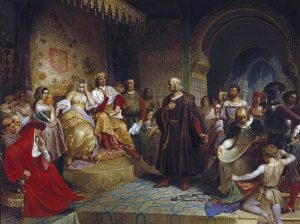
- Oliver Dunn, James E. Kelley, Jr, The Diario of Christopher Columbus’s First Voyage to America 1492-1493, 1st Edition, University of Oklahoma Press: Norman and London, 1989. 65. ↵
- David L. Bender, Bruno Leone, and Mary Ellen Jones, Christopher Columbus and His Legacy: Opposing Viewpoints, 1st Edition, (Greenhaven Press Inc., 1992), 11. ↵
- Oliver Dunn, James E. Kelley, Jr, The Diario of Christopher Columbus’s First Voyage to America 1492-1493, 1st Edition, (University of Oklahoma Press: Norman and London, 1989), 59. ↵
- Oliver Dunn, James E. Kelley, Jr, The Diario of Christopher Columbus’s First Voyage to America 1492-1493, 1st Edition (University of Oklahoma Press: Norman and London, 1989), 63. ↵
- Oliver Dunn, James E. Kelley, Jr, The Diario of Christopher Columbus’s First Voyage to America 1492-1493, 1st Edition, (University of Oklahoma Press: Norman and London, 1989), 63. ↵
- Oliver Dunn, James E. Kelley, Jr, The Diario of Christopher Columbus’s First Voyage to America 1492-1493, 1st Edition (University of Oklahoma Press: Norman and London, 1989), 65. ↵
- Oliver Dunn, James E. Kelley, Jr, The Diario of Christopher Columbus’s First Voyage to America 1492-1493, 1st Edition (University of Oklahoma Press: Norman and London, 1989), 65. ↵
- Oliver Dunn, James E. Kelley, Jr, The Diario of Christopher Columbus’s First Voyage to America 1492-1493, 1st Edition, (University of Oklahoma Press: Norman and London, 1989), 69. ↵
- Oliver Dunn, James E. Kelley, Jr, The Diario of Christopher Columbus’s First Voyage to America 1492-1493, 1st Edition, (University of Oklahoma Press: Norman and London, 1989), 71. ↵
- Oliver Dunn, James E. Kelley, Jr, The Diario of Christopher Columbus’s First Voyage to America 1492-1493, 1st Edition, (University of Oklahoma Press: Norman and London, 1989), 87. ↵
- Oliver Dunn, James E. Kelley, Jr, The Diario of Christopher Columbus’s First Voyage to America 1492-1493, 1st Edition, (University of Oklahoma Press: Norman and London, 1989), 87. ↵
- Oliver Dunn, James E. Kelley, Jr, The Diario of Christopher Columbus’s First Voyage to America 1492-1493, 1st Edition, (University of Oklahoma Press: Norman and London, 1989), 87, 88. ↵
- Oliver Dunn, James E. Kelley, Jr, The Diario of Christopher Columbus’s First Voyage to America 1492-1493, 1st Edition, (University of Oklahoma Press: Norman and London, 1989), 89. ↵
- Oliver Dunn, James E. Kelley, Jr, The Diario of Christopher Columbus’s First Voyage to America 1492-1493, 1st Edition, (University of Oklahoma Press: Norman and London, 1989), 93. ↵
- Oliver Dunn, James E. Kelley, Jr, The Diario of Christopher Columbus’s First Voyage to America 1492-1493, 1st Edition, (University of Oklahoma Press: Norman and London, 1989), 111-119. ↵
- Oliver Dunn, James E. Kelley, Jr, The Diario of Christopher Columbus’s First Voyage to America 1492-1493, 1st Edition, (University of Oklahoma Press: Norman and London, 1989), 403. ↵
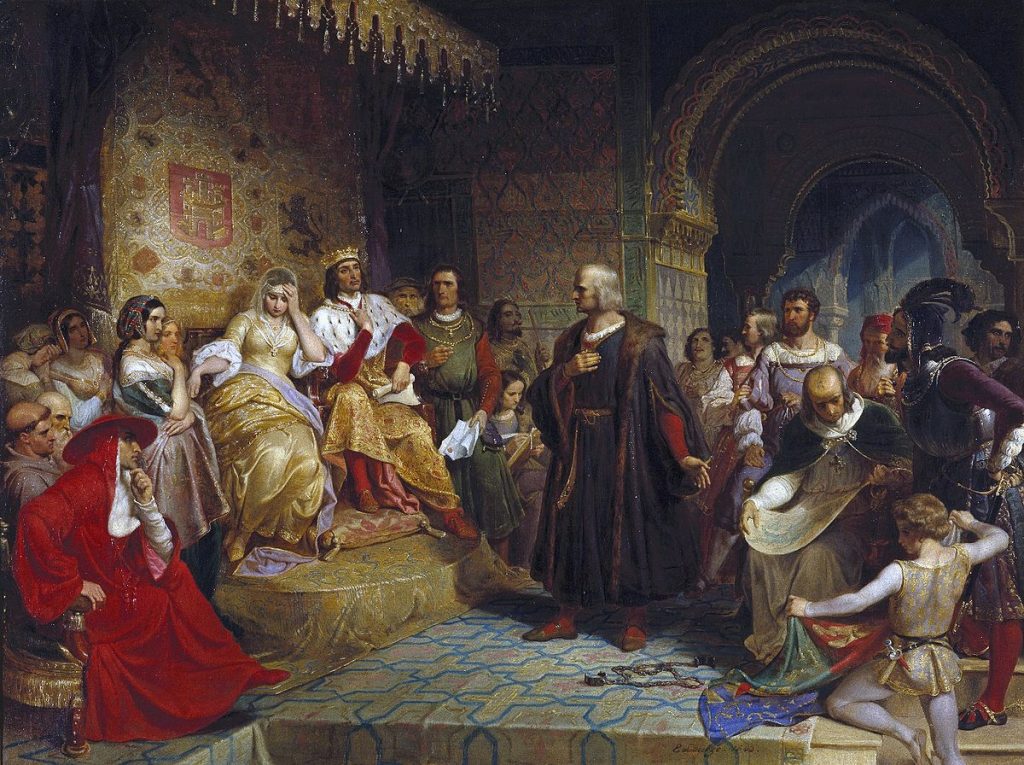

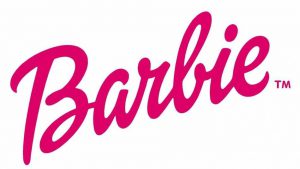

23 comments
Michaell Alonzo
Hey Esteban, congrats on being nominated for an article award. This post was so beautifully written and fascinating to read. This page has an astonishing quantity of specific information. Although there are many articles about Christopher Columbus, it is always intriguing to hear another person’s take on the man. Our country’s past, in my opinion, is something that should get greater attention yet is routinely disregarded. I really adored the pictures you chose, which perfectly complemented the narrative you were presenting. I really appreciated how well-organized you were; it made the reading interesting for me.
Rawan Hawsawi
This was definitely an informative article about some of the events said to occur during the colonization of the Americas. I have read a lot of articles on Christopher Columbus, and it is always interesting to hear a different point of view on who he was as a person. I think the history of our country is something that is widely looked over and should be brought to light
Fatima Esparza
Great article! It was fascinating reading about the controversial story of Christopher Columbus’s journey. His descriptions of the natives were more polite than I thought he would have written, describing how some of them were “handsome” and the clothing they wore. His ambition to find gold was prominent to him and made his journey last longer. His journey is controversial, in my opinion, because his search for conquest led to the destruction of many people and communities, which only got worse over time.
Elliot Avigael
Congrats on your nomination! It was great to see a more in depth version of the Columbus story, with your included excerpts from the man himself. I think his personal experiences of what he encountered on those islands are regularly overlooked in American history, and give a lot more like to what he experienced on those islands.
Sierra Christa
Great article! I deeply enjoyed reading further on early American studies. This article integrated the excerpts from his diary very well. I never knew he documented everything he saw and encountered for Queen Elizabeth. It also highlighted and showed just how Columbus viewed the Native Americans. I think this article did a fantastic job on showing the correlation between the literal journal and first hand account with setting foot on the newly found land and the recent controversy on the matter.
Jose Luis Gamez, III
Great imagery in your article. I enjoyed learning that Christopher Columbus kept a diary/journal. This is something that I had no prior knowledge in reading and learning about Columbus in high school. Congratulations on your nomination!
Alia Hernandez Daraiseh
Congrats on your article being published, this article has so many amazing elements in it that allow the story to flow so elegantly. I knew a general idea of Christopher Columbus, but I did not know the things he did personally. This provides insight into how Christopher Columbus’s thought process and perception of the world and people was like.
Joshua Marroquin
The fact that this essay highlighted a few colonization-era occurrences made it a joy to read. I’ve studied a lot about Christopher Columbus and have picked up a lot of knowledge. I found this article interesting because of the pictures. Your research was excellent. My interest in Columbus and his writings increased as a result. Next time, I’d like to hear more from your article.
Brandon Vasquez
Congratulations on your nomination! This article was amazing and really highlighted the events during the colonization of the Americas. Christopher Columbus is one of the most well known historical figures in history due to his discoveries but is also one of the most controversial. I think if we knew everything that happened when Columbus came to the Americas it would be fascinating but also very cruel for our time today.
Helena Griffith
This article regarding some of the alleged incidents that took place during the colonization of the Americas was very enlightening. Christopher Columbus has been the subject of several writings, and it is always intriguing to hear different perspectives on who he was as a person. I believe that the history of our nation deserves to be made more widely known because it is something that is sometimes overlooked.